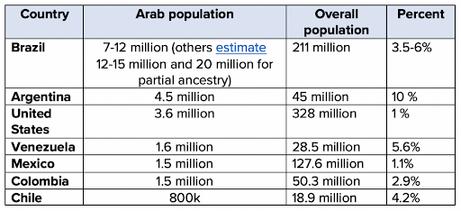
3 minute read
Middle East Diaspora to Latin America
by: Anusha Natarajan
Latin America has been an ever-growing region of the world that holds rich history and culture Thousands of Indigenous peoples have resided in a wide variety of countries in the region and have influenced language and cuisine for centuries to come
Advertisement
Opportunity brought the Spanish and Portuguese into Latin America during the 16th century. They began to shape Latin America in bringing in the social hierarchical systems, religion, and diseases.
The 19th century then hit, and several of the countries received independence from Spain and Portugal, and began to build their own identities in establishing a government representing the people. The 19th century was not only known for independence revolutions, but it was also one of the crucial centuries that brought together immigrants from different places around the world. In the U.S., there were a series of immigration waves that brought in different communities The first wave was primarily British migrants, and the second wave consisted of German and Irish migrants The element that united these communities: is opportunity Same can be said for the Middle Eastern and North African migrants who made their way to Latin America from the Ottoman empire The Ottoman empire was experiencing a slow downfall when it came to garnering economic opportunities and social mobility. Between 1860 and 1914, nearly 600,000 migrants from the Middle East arrived in Latin America in search of those opportunities for themselves and the future generations.
Upon arrival, Middle Eastern populations were quick to establish their presence in the countries by bringing in their language, culture, and other crucial traditions to maintain their identity.
In 1893, Syrian and Lebanese immigrants in Brazil developed the first Arabic newspaper in the region, known as Al-Fayha.

When the Palestinains arrived in Chile, they developed a football club, known as the Palestino, which still continues to participate in playing the sport of football.

They often converted to Catholicism, as that was the major religion in the region.
They also faced stereotyping from the Latin American community on their race and culture. Racially, Arabs were not considered to be European initially, resulting in rising questions on where they fit in society They were stereotyped by the larger community as cannibals because of their cuisine consisting of raw kibbeh, which is a Lebanese steak dish.
Some cultural changes that Arab immigrants incorporated when arriving to Latin America was their surname. Similar to immigrants anglicizing their surnames when arriving to the U.S., several Arab migrants latinized their surname For instance, the Arabic word for war is ‘Harb’, and people switched their surname to ‘Guerra’, which is war in Spanish.
Historically, Arabic culture has been influential in the development of the Spanish language. When the Moors arrived in Spain in 711, they transformed Spanish society academically and culturally. Several words in Spanish hold Arabic origins, such as Azúcar = sugar and Aceite = oil. Arab immigrants faced less hurdles when it came to assimilating into Hispanic culture because many of them were already coming from Christian backgrounds.
Arabs were known for introducing the credit line system, which propelled the modern commercial finance movement. Typically, Middle Eastern communities tended to cluster around an urban area, creating an ethnic enclave. In Brazil, central Rua de 25 Março is one of the neighborhoods where the Arab population was concentrated in Rio. In Ecuador, Arab migrants lived in San Pedro Sula. A second wave of Middle Eastern migrants occurred shortly after World War II due to the rising tension in the Middle Eastern region in response to the creation of Israel, which eventually led to a series of civil wars in the region. Many of these migrants moved to Argentina, Chile, Brazil, and Paraguay.
Today, there are between 14 to 30 million individuals who have Arab ancestry or of Arab descent in South America. Brazil holds the largest number of people with Arab descent, which consists of nearly 9 million inhabitants in the country. Chile has the largest Palestinian population outside of the Middle East.
Many of them have held leadership positions in government, such as the presidency. Carlos Menem, Abdala Bucaram, and Nayib Bukele are examples of Arab descent Hispanic leaders leading their respective countries in the past and present.
Arab Latinos have also made a presence in the entertainment industry, such as musician Shakira and actress Salma Hayek, both who have Lebanese ancestry.
*Sources
Image from: https://www google com/url?q=https://sole digital/the-arabdiaspora%23: :text%3DToday%252C%2520estimates%2520put%2520th e%2520Arab,of%2520Lebanese%2520or%2520Syrian%2520descent&sa =D&source=docs&ust=1676494369099789&usg=AOvVaw0MC6RQawJw D-scg45 qwnU
*https://www oxfordbibliographies com/display/document/obo9780199766581/obo-9780199766581-0193 xml
*https://www.iemed.org/publication/the-arab-world-and-latinamericalong-standing-migration-an-expanding-south-southpartnership/

*https://www.atlanticcouncil.org/blogs/menasource/viva-losarabes-underreported-stories-of-the-arabs-of-the-americas/
*https://www arabnews com/node/2076336/middle-east
*https://www.thenation.com/article/archive/arabs-latin-america/






